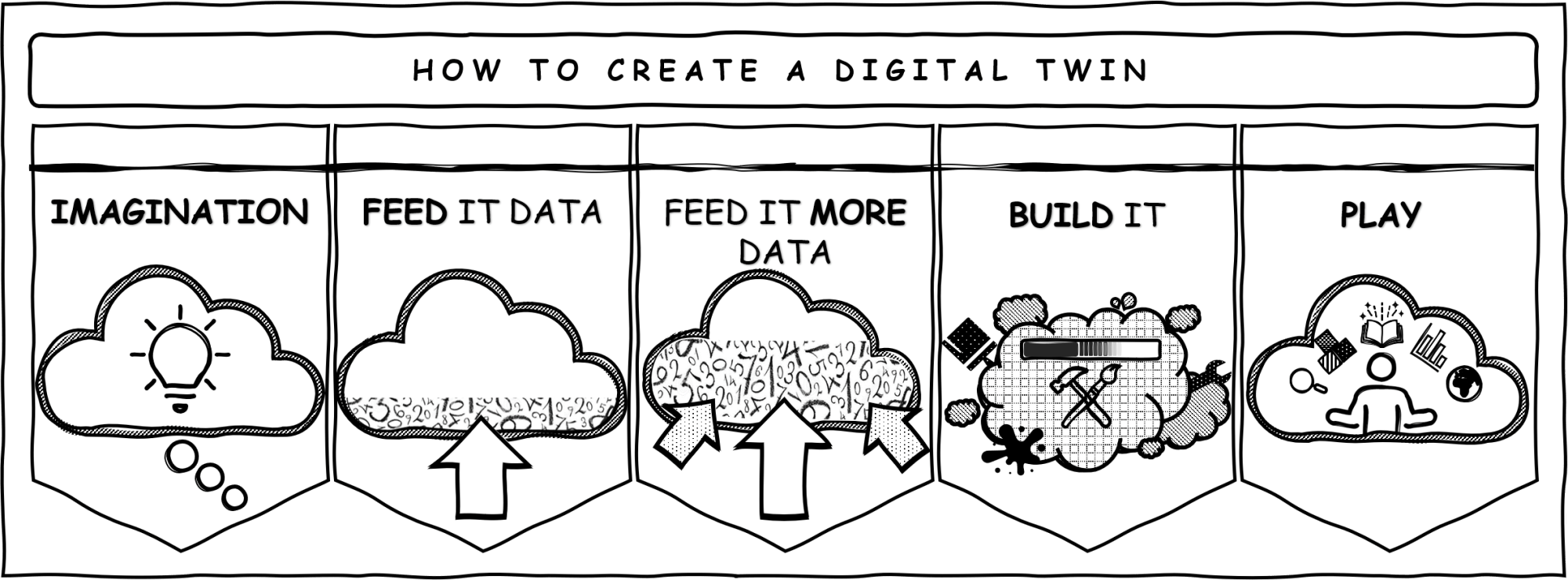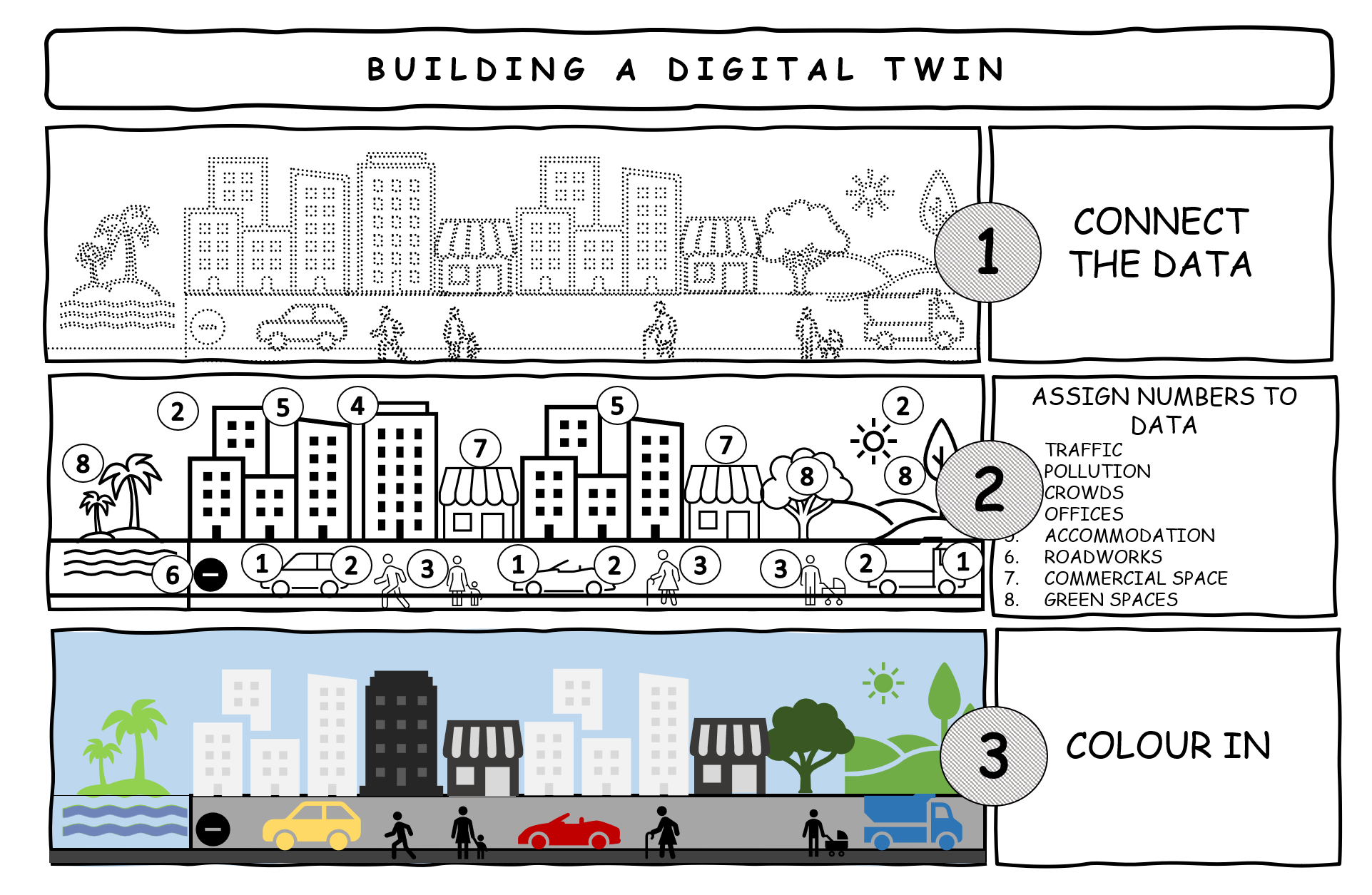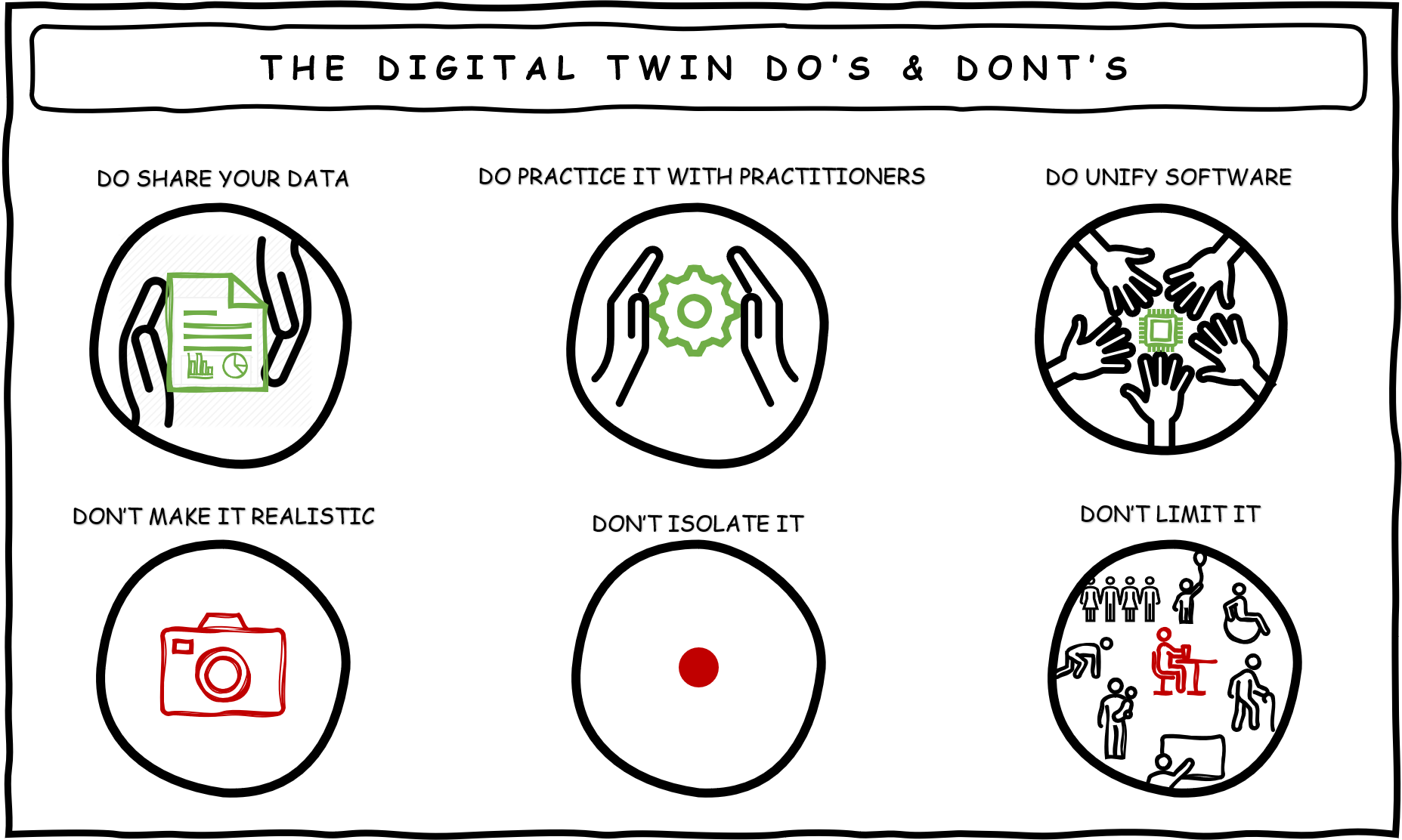What is a Digital Twin?
Initially I wanted to say a Digital Twin is a digital version of anything I can see around me, but after reading our Digital Twin series, I do not believe that definition does a Digital Twin justice.
The word “version” implies that a Digital Twin is static and captures a moment in time. From what I’ve learnt from this series a Digital Twin is a more organic and agile structure that operates and reacts in real-time and is up-versioning ahead of us.
Secondly, a Digital Twin is not always about what I can see around me directly. Whether it be pollution, virus spread or the behaviour of people, a Digital Twin can provide insights into parts of our environment that I cannot see.
Given these two points, I would say that my revised definition of a Digital Twin would be: A digital environment that reflects on, mirrors, and evolves ahead of the physical environment.
However, when we’ve asked the same question to all our interviewees in this series everyone has had similar, but different, answers which says to me that whilst a definition is useful, I’m not sure this is really the best way of understanding a Digital Twin. The best way I have learnt to understand a Digital Twin is by what solutions it seems to provide to different people.
What can a Digital Twin do for me?
When I look back on the series, the most basic thing it can do for us is showing us all possible outcomes from a single decision before we go ahead with it.
And it doesn’t have to be complicated decisions: One of the first bits of information we ever looked into for playing around with visualisations at Slingshot was breakfast cereal types. Crazy complicated stuff.
However, the blogs in this series have highlighted that Digital Twins can serve completely different parts of our environment, economy, and society in very different ways and at varying levels of complexity.
This comes down to a Digital Twin being essentially meaningless until you put data into it. Being sentimental, it is nothing without you. The more information you give and the wider variety of information it is, the more detailed and varied scenarios it can show.
So, how do you make a Digital Twin?

Start with your imagination
We cannot limit the development of Digital Twins based on what is possible. Zandra Moore (Panintelligence) touched on this in her interview for this series: Digital Twins can be created and defined by its solutions rather than what it does in technological terms. This requires imagination on our part to figure out what issues we want it to solve rather than be told what we can do with it.
The amount of data we have is comparatively gigantic to the amount of ideas around how to use it, and this can come from being intimidated by the amount of data we have and seeing it as a mess of numbers rather than meaningful information.
For Digital Twins to produce something meaningful we need to reclaim that mess and wield it for our benefit, and that requires an adjustment of how we approach technology in general.
The complicated design of technology can often make us feel like we are serving it, rather than the other way around, but by using our imagination and not limiting ourselves to what we think is possible, we can tell Digital Twins what we need it to be, which sets us up with a shopping list of what you need to make a Digital Twin.
Feed it Data
After the initial idea, Digital Twins begin and end with data. The more the better.
And you must feed it data. In part 3 of this series, Dr He Wang, (University of Leeds), described data as food provision for a Digital Twin; if you don’t give it, and continue to feed it data, then it won’t evolve and transform with the environment it was told to digitise. To tell the story of organic elements it needs to behave like an organism, which involves treating it as such: feeding it, teaching it and help it grow.
Then, Feed it MORE Data
The primary advantages of having more data in a Digital Twin is fairly apparent, but one benefit that is becoming more and more valuable in this area is the ability to create context.
A Digital Twin is more than just simulating an element for prediction and information: its about simulating an environment in a way that tells the best story to the user.
Some of the best novels are ones that have a plethora of backstory behind the narrative. From character biographies to a millennium of history, fictional laws and mannerisms, all these extra details contribute towards a more immersive and interesting literature world that sparks conversations and ideas for years after they were written.
Whilst not fictional, Digital Twins possess the same capability: giving it more data about the wider environment helps tell a better story about a specific subject or, as Stuart Howie (Avison Young) explains it, Digital Twins “offer the ability to look at individual intervention projects in the context of a wider place model. This offers a powerful evaluation ability compared to just assessing an individual project, executing it, and then stepping back and seeing what that does to the rest of the ecosystem in retrospect.”
Build it

The Digital Twin blogs from the Slingshot Development team highlight that Digital Twins are not quite at the point where we can simply drop stuff into it and let it spit out a twin – we need to tell it what we want more specifically.
The best way I could understand how to make a Digital Twin was to see it like an activity that resembles a hybrid of connect the dots and paint-by-numbers.
When you put all your data in and tell it to get started, the Digital Twin’s simulator will look at all the data you gave it and begin by arranging the results on a page and connecting them all up to form an initial sketch of what the twin will look like, very much like connect the dots.
But at this point this is just an outline of our Digital Twin, so the simulator will do a more in-depth exploration of the data and start assigning the data specific shapes and areas within the initial sketch and give the same types of data within that sketch a number. From there it can start to “colour it in” based on the shapes and numbers it assigned, just like paint-by-numbers. When its completed I will have a finished work of art – a fully functioning Digital Twin.
Is this oversimplifying the Agent-Based modelling method that the development team touched on in their blog? Of course it is, but that is kind of the point.
For Digital Twins to be built by anyone, we need to strip away all the fancy PHD level words and tell it like it is: Very few people will know how to do Agent-Based Modelling but everyone will admit to be capable of doing a paint-by-numbers, advanced or simple ones. Once we start talking about technology in less pretentious terms, anyone will be confident enough to create a Digital Twin.
Play
One of Will Schaffer’s (Mercia Technologies) biggest points in his Digital Twin blog was the ability to play with a Digital Twin. Once you have created that Digital Twin, you now have the opportunity to tweak it, edit it, and try as many different scenarios as you want. Many of our Digital Twin interviewees defined Digital Twins as a “virtual testbed” and this is exactly what you can do with it once you have created it.
As I mentioned in my initial definition, a Digital Twin is never static so once you’ve made it, you can re-make it, play with it and re-run it as much as you want so you can explore all possible options and make more informed decisions.
The Digital Twin Do’s & Dont’s

DO: Share your Data
One of the biggest issues facing Digital Twins today is that there are mountains of data squirreled away in private organisations: totally unavailable but infinitely valuable.
Like most things, there must be a balance. Whilst we should be encouraging people to share, no one brings their fine china to a pot-luck dinner. And there are some things that cannot be shared. However, as Stephen Blackburn points out in Part 5 of this series, if companies do not make more of their data accessible then we are going to have holes in our Digital Twin.
Zandra had an important reminder for us all in the previous blog: When it comes to these types of data platforms the data is not the platform’s property, its other peoples. Data doesn’t simply appear in a Digital Twin, we have to provide data to go with it and the more data we share, the better the Digital Twin will be.
DO: Put it into practice with the people who will actually use it
There’s no denying it – Digital Twins look great. But this runs the risk of pushing Digital Twins into a trending fad, like Business Transformation or Scoobie strings.
As Will suggested in his interview for Digital Twins, software is often acquired by networking and connections which can result in only one person out of an entire company who knows how to use it and the remaining 99% of the organisation being told to use a piece of software they don’t know how to use or why they need it.
For Digital Twins to integrate into society we need to put it into the hands of the practitioners: the people who end up using it on a day-to-day basis and design it for them rather than the technologists or the CEOs.
DO: Use it to unify existing software
Former VP of Herman Miller, Stephen Perkins’ blog in the Digital Twin series emphasised the need to start listening more to our staff and what they need out of their working space. Whilst this refers primarily to the physical working environment, with more and more technology being developed, we need to start designing our software environment with the same responsiveness.
If you keep adding multiple extensions to your home, it gets to a point where you wonder whether it’s easier to buy a new house – the same applies for software. Rather than keep adding more software that achieves one little piece of the overall outcome and crams yet another program into employees computers, it might be better to have just one piece of software that can bring all your requirements together.
A Digital Twin has the potential to sit on a platform that can unify software and provide an environment that allows for consistency in result and appearance whilst taking in information from other sources. That way you can re-house your software environment in a brand-new building – A Digital Twin. All the same stuff inside, but one unchangeable unit that allows for evenness in outcome and only one piece of tech you need to use.
Don’t: Make it realistic
We need Digital Twins to be immersive not realistic. As we heard from Prof Richard Romano (University of Leeds) in Part 2 of the Digital Twin Series: Photorealism opens creators up for error, should one thing element not be 100% realistic, as it “trips” the user up which dissolves the immersion and you may lose the ability to gather genuine interactions between people and place.
There must be a willing suspension of disbelief. If we allow the data to be placed into an environment that looks similar to reality, but isn’t, our brain will accept this and move on, as what you will see will be generated by real data. If Aristotle believed you could, you can.
Its this kind of belief that has informed how we have designed our 3D world at Slingshot. By making the Digital Twin cartoon-like it allows the data being modelled to speak for itself rather than being overshadowed by poorly rendered photographs and clears the path for the data to better inform.
Don’t: Isolate a Digital Twin
Whilst we’re living in a world where more and more barriers are going up, we need to make way for technology to help us collaborate come together in other ways. Whilst we create Digital Twins around a specific project or space, we should always design a Digital Twin with the awareness that there is so much more that it could connect to.
Don’t: Assume its just for Businesses
Let’s not get confused: A Digital Twin isn’t a Magic 8-Ball. Digital Twins are in the business of forecasting not fortune telling. However, this does not mean we can’t benefit from it on an individual level. One thing all our interviewees mentioned individually was a Digital Twins ability to impact society drastically, especially the way we move and behave in our communities and wider environments.
We are always as a society looking for sustainable solutions to wasteful problems and a lot of this must start at home and with the home. Looking at Stuart’s view on Digital Twins and Urban Regeneration, He and Stephen’s views on adaptability and re-use of spaces, and Zandra and Stephen Blackburn’s (Leeds City Council) view on Digital Twins and the re-vitalising of Social housing, it starts to show one important fact about what a Digital Twin is: A recycling plant by which we can contribute what we already have around us and process it in such a way that produces new options and information from existing resources without having to waste resources in order to find the solution.
In summary
To that end, I think the best way to summarise Digital Twins is that is must start with people not the product. Whether it’s based on wanting a Digital Twin of people in a place, people in the anatomical sense, or for people to learn from, it we are not placing humans at the centre of Digital Twins then it will struggle to gain traction or find a purpose beyond modelling.
Being able to generate a Digital Twin of an environment that allows us to reflect on what we’ve done previously, to what we’re doing now, then to what we could be, is a huge opportunity to start regaining control of our environments, and start telling our own story based on our vision for a people or place.
Being able to forge new paths for society based on informed decision-making and analysis of all possible scenarios is a Digital Twins greatest weapon, and is an opportunity that should be accessible to all and not to be missed out on.
*Update: Is there an official definition of a Digital Twin?
Yes! Since we wrote this blog the Digital Twin Consortium announced their official definition at the end of 2020:
A digital twin is a virtual representation of real-world entities and processes, synchronized at a specified frequency and fidelity.
- Digital twin systems transform business by accelerating holistic understanding, optimal decision-making, and effective action.
- Digital twins use real-time and historical data to represent the past and present and simulate predicted futures.
- Digital twins are motivated by outcomes, tailored to use cases, powered by integration, built on data, guided by domain knowledge, and implemented in IT/OT systems.
You can read the article on their definition here: https://blog.digitaltwinconsortium.org/
More in the Series:
- What are Digital Twins today?
- Humancentric Digital Twins
- Personal Digital Twins
- Agent-based Modelling for Digital Twins
- Digital Twins and Decision-Making: Leeds City Council
- Digital Twins and Decision-Making: Urban Regeneration
- The Role of Simulation in Decision-Making
- Investing in Digital Twins
- End of Open Plan Offices? Smart Solutions for a Safer Office
- Data Insights, Digital Twins and Dashboards
- Digital Twins for Beginners
- Series Summary
